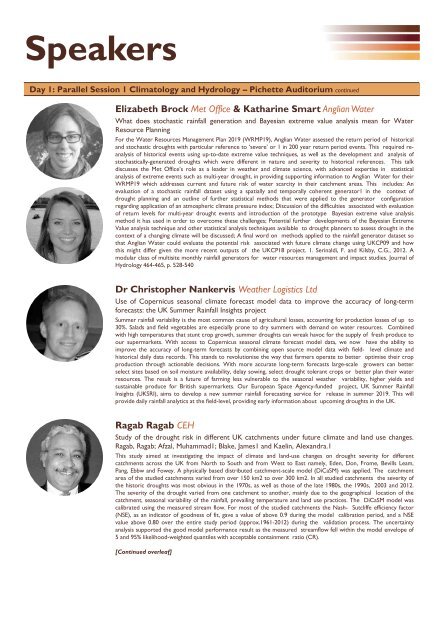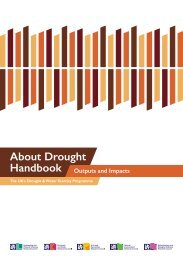DelegatePack_DroughtConference_20-21March2019
Create successful ePaper yourself
Turn your PDF publications into a flip-book with our unique Google optimized e-Paper software.
Speakers<br />
Day 1: Parallel Session 1 Climatology and Hydrology – Pichette Auditorium continued<br />
Elizabeth Brock Met Office & Katharine Smart Anglian Water<br />
What does stochastic rainfall generation and Bayesian extreme value analysis mean for Water<br />
Resource Planning<br />
For the Water Resources Management Plan <strong>20</strong>19 (WRMP19), Anglian Water assessed the return period of historical<br />
and stochastic droughts with particular reference to ‘severe’ or 1 in <strong>20</strong>0 year return period events. This required reanalysis<br />
of historical events using up-to-date extreme value techniques, as well as the development and analysis of<br />
stochastically-generated droughts which were different in nature and severity to historical references. This talk<br />
discusses the Met Office’s role as a leader in weather and climate science, with advanced expertise in statistical<br />
analysis of extreme events such as multi-year drought, in providing supporting information to Anglian Water for their<br />
WRMP19 which addresses current and future risk of water scarcity in their catchment areas. This includes: An<br />
evaluation of a stochastic rainfall dataset using a spatially and temporally coherent generator1 in the context of<br />
drought planning and an outline of further statistical methods that were applied to the generator configuration<br />
regarding application of an atmospheric climate pressure index; Discussion of the difficulties associated with evaluation<br />
of return levels for multi-year drought events and introduction of the prototype Bayesian extreme value analysis<br />
method it has used in order to overcome these challenges; Potential further developments of the Bayesian Extreme<br />
Value analysis technique and other statistical analysis techniques available to drought planners to assess drought in the<br />
context of a changing climate will be discussed; A final word on methods applied to the rainfall generator dataset so<br />
that Anglian Water could evaluate the potential risk associated with future climate change using UKCP09 and how<br />
this might differ given the more recent outputs of the UKCP18 project. 1. Serinaldi, F. and Kilsby, C.G., <strong>20</strong>12. A<br />
modular class of multisite monthly rainfall generators for water resources management and impact studies. Journal of<br />
Hydrology 464-465, p. 528-540<br />
Dr Christopher Nankervis Weather Logistics Ltd<br />
Use of Copernicus seasonal climate forecast model data to improve the accuracy of long-term<br />
forecasts: the UK Summer Rainfall Insights project<br />
Summer rainfall variability is the most common cause of agricultural losses, accounting for production losses of up to<br />
30%. Salads and field vegetables are especially prone to dry summers with demand on water resources. Combined<br />
with high temperatures that stunt crop growth, summer droughts can wreak havoc for the supply of fresh produce to<br />
our supermarkets. With access to Copernicus seasonal climate forecast model data, we now have the ability to<br />
improve the accuracy of long-term forecasts by combining open source model data with field- level climate and<br />
historical daily data records. This stands to revolutionise the way that farmers operate to better optimise their crop<br />
production through actionable decisions. With more accurate long-term forecasts large-scale growers can better<br />
select sites based on soil moisture availability, delay sowing, select drought tolerant crops or better plan their water<br />
resources. The result is a future of farming less vulnerable to the seasonal weather variability, higher yields and<br />
sustainable produce for British supermarkets. Our European Space Agency-funded project, UK Summer Rainfall<br />
Insights (UKSRI), aims to develop a new summer rainfall forecasting service for release in summer <strong>20</strong>19. This will<br />
provide daily rainfall analytics at the field-level, providing early information about upcoming droughts in the UK.<br />
Ragab Ragab CEH<br />
Study of the drought risk in different UK catchments under future climate and land use changes.<br />
Ragab, Ragab; Afzal, Muhammad1; Blake, James1 and Kaelin, Alexandra.1<br />
This study aimed at investigating the impact of climate and land-use changes on drought severity for different<br />
catchments across the UK from North to South and from West to East namely, Eden, Don, Frome, Bevills Leam,<br />
Pang, Ebbw and Fowey. A physically based distributed catchment-scale model (DiCaSM) was applied. The catchment<br />
area of the studied catchments varied from over 150 km2 to over 300 km2. In all studied catchments the severity of<br />
the historic droughts was most obvious in the 1970s, as well as those of the late 1980s, the 1990s, <strong>20</strong>03 and <strong>20</strong>12.<br />
The severity of the drought varied from one catchment to another, mainly due to the geographical location of the<br />
catchment, seasonal variability of the rainfall, prevailing temperature and land use practices. The DiCaSM model was<br />
calibrated using the measured stream flow. For most of the studied catchments the Nash- Sutcliffe efficiency factor<br />
(NSE), as an indicator of goodness of fit, gave a value of above 0.9 during the model calibration period, and a NSE<br />
value above 0.80 over the entire study period (approx.1961-<strong>20</strong>12) during the validation process. The uncertainty<br />
analysis supported the good model performance result as the measured streamflow fell within the model envelope of<br />
5 and 95% likelihood-weighted quantiles with acceptable containment ratio (CR).<br />
[Continued overleaf]




